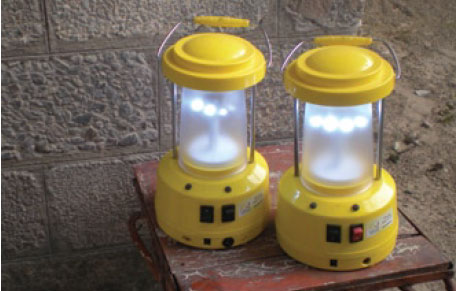| Case: India - Solar Lantern Charging Station | ||
| ||
AIWC/USAID –SARI Energy Project for Income Generation through Solar Lantern Charging Station
By
Lalita Balakrishnan, All India Women’s Conference
(AIWC)
This program include the evolve training methodology for women SHGs for
livelihood and income generation on solar electricity initiative at Sangam
Vihar & Dakshinpuri
was undertaken.
Under this program, we have selected leaders, provide awareness and training
of solar devices and assist in installing the charging stations, the long
term objective is to develop women’s capacity to install, use, maintain
and repair solar devices and start entrepreneurial based on solar devices
and augments
the incomes of women from these low income groups.
There is profitable business in solar lanterns'- In AIWC experience, many individual
users especially in the resettlement areas fail to charge the lanterns regularly
with the result they go into deep discharge and they give a bad impression
about the efficiency of the lantern. In our most recent project, we have realized
that when you have a central charging station, the lady in whose terrace the
panel has been installed, charges all the solar lanterns carefully. This way
without the small panels the costs of the solar lanterns becomes very affordable,
for the women from the lower income group.
Another plus point is the same women have formed their own self help groups
who have all been helped to open individual accounts, in the bank where they
deposit regularly whatever they save. Another thing we have noticed is that
interaction between these women becomes very good and in fact in Sangam Vihar
resettlement Colony, the solar panel is installed in the terrace of a Hindu
lady, and the lanterns are charged in the adjacent house terrace of a Muslim
Lady and women are waiting for upscale of the project and we can replicate
same in various regions.
And we also realized that there was need of purifier dirking water in these colonies because of a large number people fall ill due to contaminated water. So we had installed the water purifier which runs through solar energy and they are also selling the purifier water to needy people in nominal charges and earn a additional income and prevent people from contaminated water.
Under this project,
we have trained the large number of the local women in the maintenance and
the
best use of solar lanterns to be charged through solar
charging station and renting out. We have also installed two solar lanterns
charging station of 50 lanterns each, at Sangam vihar and Dakshinpuri, New
Delhi. By renting out one solar lantern, they are earning Rs 300 per month,
through this way; they are able to earn an additional income from solar charging
station. Towards the advocacy, Recently AIWC has conducted more than 15 solar
energy fairs in Delhi & Gujarat states of India. We brought the manufactures,
Users and concerned government officer in the same platform so that the problems
in implementing the programs could be discussed and shorted out and through
this a numbers of residence welfare association have came forward to install
the various solar devices in their respective areas and in fact one of the
solar fairs at IGNOU, the Vice-Chancellor allowanced as follow up of this program
that they will install solar water heating in all the staff Quarters (350)
From two solar charging station we can save carbon emission upto 180 tonnes.
Av. kerosene oil used per house hold/hawker per month = 5 L
Annual kerosene oil used per house hold/ hawker = 12*5 = 60 L
Annual Carbon emission per house hold/ hawker = 180 kg (from 60 L of Kerosene
oil)
Therefore,
form 100 solar lanterns = carbon emission = 180*100 = 18 Tonnes/annum
We are expecting
that the project life will be more than 10- 12 yrs, so we can save carbon
emissions upto 180 tonnes form this project.
More information:
www.aiwc.org.in/
INFORSE’s Manual’s Solar Section: “Sustainable Energy Solutions
to Reduce Poverty in South Asia” www.inforse.org/asia/M_III_solarPVsystems.htm
 |
|
| Energy Access | |
| Contents Solutions to provide energy access for all Cases: |
|
| AFRICA | |
| · Kenya: Decentralizing Power Policy | |
| · Kenya: Afforestation for Charcoal | |
| · Mali: Jatropha Biofuel for Rural Electrification | |
| · Mali: Solar Lighting Kits for Rural Areas | |
| · Uganda: Feed-in Tariff for Renewable Energy | |
| ASIA | |
| · India: Solar Dryer | |
| · India: Solar Lantern Charging Station | |
| · India: Household Biogas Plant | |
| · India: Micro-Agroecological Village Development Model | |
| · Nepal: Improved Water Mills | |
| · Nepal: Charging Centre for Solar Lamps | |
| · Sri Lanka: Commercialization of Improved Cookstoves | |
| · Sri Lanka: Standard Code for Domestic Biogas Systems | |
 |
|
The
cases were collected in the framework of the "Southern Voices on Climate
Change" Project. Link: www.climatecapacity.org INFORSE-Asia and INFORSE-Africa |
|
